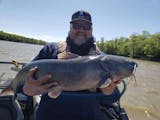
Achieve Pre-Spawn Walleye Fishing Success
In the early spring, Walleye fishing enthusiasts eagerly anticipate the resurgence of these elusive predators. As the ice begins to thaw and the water temperature rises, Walleye become more active, making them prime targets for anglers. In this guide you will learn more about Pre-Spawn Walleye behavior, and the baits that are key players during this transition. Let’s dive in!
Pre-Spawn Walleye Behavior
Understanding the nuances of Walleye behavior throughout spring is crucial for successful fishing during this dynamic season. Early on, anglers target pre-spawn Walleye, typically found near the bottom in depths of around 15 feet or more, often congregating along routes to spawning areas. As water temperatures rise towards 40°F, Walleye migrate to shallow waters near shoreline structures, inlets, and dams for spawning. It's important to note that Walleye activity correlates closely with water temperature, with colder waters leading to decreased activity and a preference for slower-moving baits. As temperatures rise, Walleye become more active and exhibit phases of increased feeding aggression.
Best Techniques and Baits for Pre-Spawn Walleye
Vertical Jigging
Vertical jigging from a boat is a top-notch strategy for targeting early spring Walleye, especially when they're near the bottom in deeper waters or near structure. Let your jig sink down, then gently lift your rod tip to create an enticing motion before allowing it to settle back down. Keep a keen eye on your line for subtle strikes. When dealing with more active fish, try snap jigging—rapidly lift your rod tip to snap up the jig, then let it sink slowly. Strikes are often triggered during this descent.
Baits We Recommend:
- Rapala Jigging Shadow Rap 09
- Rapala Snap Rap Jig 2 1/2 inch SNR06 Jigging Lure
- Lunkerhunt Straight Up Ice Jig
- Lindy Fuzz-E-Grub Pre-Rigged Hair Tail Soft Grub 2 pack
Jigs/Jigheads
Using jigs and jigheads is an excellent method for covering water in shallow coastal areas or flats, suitable for both shore and boat fishing. Begin by casting the jig and allowing it to sink to the bottom. Then, start a steady retrieve, interspersed with occasional lifts and drops of the rod tip to attract Walleye. For spring Walleye, round jigheads paired with paddle tail swimbaits, plastic grubs, or minnow imitations are recommended. When fishing close to the bottom, the Ned Rig is favored for its upright stance, which can trigger bites even in inactive fish. Some anglers advocate for hair jigs due to their natural, subtle action underwater. Experimenting with different colors, sizes, and styles is essential for finding the most effective setup in local waters.
Baits We Recommend:
- VMC Neon Moon Eye Jig 1/4 - 1 oz. Jigheads
- VMC Moontail Jig
- Z-Man Finesse ShroomZ Jigheads 5 pack
- Keitech Easy Shiner 4 inch Paddle Tail Swimbait
Shallow Diving Crankbaits/Jerkbaits
In the initial phases of the spring season, shallow crankbaits or jerkbaits emerge as superb options for pursuing Walleyes in shallow waters. Cast these lures parallel to the shoreline or across flats, employing a deliberate, unhurried retrieve with intermittent pauses and twitches. This irregular motion often provokes aggressive strikes from voracious Walleyes.
Baits We Recommend:
- Berkley Flicker Shad Shallow Crankbait
- Berkley Hit Stick 13 - 5.1 Inch
- Rapala Shad Rap 2 inch Medium Diving Crankbait SR05
- Bomber B15 Long A 4 1/2 inch Shallow Jerkbait
Tips For Pre-Spawn Walleye Success
During the spring season, targeting Walleyes requires versatility in fishing depths and techniques. In the early morning and late evening, focus on shallow areas near spawning grounds where Walleyes feed actively. As the day progresses, shift to deeper structures as Walleyes move away from bright sunlight. Monitoring water temperature is crucial; adjust your presentation accordingly, slowing down in colder water and speeding up as it warms.
Utilize sonar technology to your advantage. Sonar is a great way to locate fish, identify structure, see baitfish schools, and temperature breaks. When you find an area with a good number of fish, mark it and repeat the process to establish a pattern for the day.
Persistence and patience are key! Cover plenty of water, experiment with different techniques, and maintain a keen eye for patterns throughout the day.
Conclusion
Pre-spawn Walleye fishing demands a blend of understanding their behavior, employing effective techniques, and selecting the right baits. As the spring season unfolds, Walleyes transition through various depths and feeding patterns, necessitating anglers to adapt their strategies accordingly. Whether it's vertical jigging, using jigs/jigheads, or casting shallow diving crankbaits/jerkbaits, there are multiple approaches to entice these elusive predators. So, as the ice thaws and the water temperatures rise, gear up, hit the waters, and embrace the excitement of early spring Walleye fishing. Tight lines!





